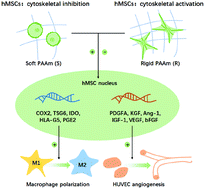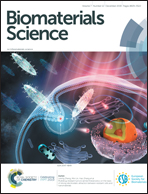Substrate stiffness affects the immunosuppressive and trophic function of hMSCs via modulating cytoskeletal polymerization and tension†
Abstract
Mesenchymal stem cells (MSCs) have broad therapeutic potential due to their ability to secrete bioactive factors that are immunomodulatory and trophic (regenerative). In this study, polyacrylamide (PAAm) hydrogels with different stiffness are used as a model to explore the effects of substrate stiffness on the paracrine function of human mesenchymal stem cells (hMSCs). Human MSCs cultured on soft substrates produced significantly higher levels of immunomodulatory and trophic factors compared with hMSCs cultured on rigid substrates. The enhanced paracrine function of hMSCs is further confirmed by the M2 phenotypic polarization observed in macrophages, as well as the accelerated chemotactic migration and angiogenesis capacity observed in human umbilical vein endothelial cells (HUVECs) after treatment with conditioned media (CM) collected from hMSCs cultured on soft substrates. Furthermore, the inhibited secretion of immunosuppressive and trophic factors by hMSCs cultured on rigid substrates is largely rescued by treatment with Lat.A, a cytoskeletal polymerization inhibitor. Similar results are observed after treatment with either myosin (Blebbi) or ROCK (Y27632) inhibitors. These results demonstrate that substrate stiffness is a key modulator of the paracrine function of hMSCs and highlight the potential utility of promoting tissue repair through stiffness-regulated paracrine signaling in MSCs.



 Please wait while we load your content...
Please wait while we load your content...